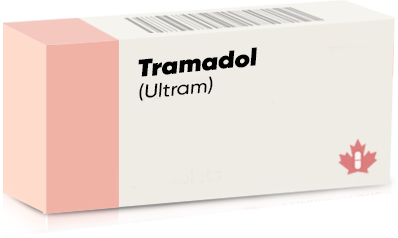| Product Name: | Tramadol (Ultram) |
| Strength: | 50mg, 100mg |
| Available packages: | 30, 60, 90, 120, 160, 200, 250, 300 pills |
| Payment Method: | E-Check | MASTERCARD |
| Price per pill: | From $3.5 |
| Shipment: | Express Delivery Service |
| Buy Now From: | VISIT PHARMACY |
Tramadol: A Quick Overview
Tramadol is a synthetic opioid analgesic that is commonly prescribed to manage moderate to moderately severe pain. Unlike other opioids, it has a dual mechanism of action, combining both opioid receptor binding and the inhibition of norepinephrine and serotonin reuptake. This unique pharmacological profile sets it apart from traditional opioids, contributing to its distinct properties and applications. Tramadol’s regulatory status varies globally. In some countries, it is classified as a controlled substance due to its opioid properties, while in others, it may be available without such restrictions. This regulatory variation underscores the complex nature of tramadol’s pharmacology and its position within the opioid landscape.
How To Use Tramadol
Tramadol, often shrouded in stories of side effects and addiction, isn’t a one-size-fits-all narrative for every patient. Its safety hinges on responsible use and adherence to guidelines. To navigate Tramadol therapy with minimal risk, follow these essential principles:
- Stick to the Prescription: Take the prescribed dosage as directed by your doctor. Avoid self-adjustments to prevent potential complications.
- Start Slow: Initiate therapy with lower dosages to mitigate acute side effects. Gradually increase as needed for optimal therapeutic effects.
- Communicate Health Issues: Inform your doctor about any significant health concerns. This ensures potential dose adjustments, minimizing the risk of Tramadol overdose.
- Meal Neutrality: Tramadol absorption remains unaffected by food. Take it with or without meals.
- Monitor Effectiveness: If you perceive diminishing effects or shorter durations, consult your doctor. Tolerance may be developing, necessitating a dose adjustment or exploration of alternative non-opioid pain relief.
When taking Tramadol orally, use a full glass of water, with or without food, and avoid crushing or breaking tablets for optimal efficacy. For liquid Tramadol, precise measurement with a syringe or special spoon is crucial. Navigate your Tramadol journey responsibly, prioritizing communication with your healthcare provider for a safer and more effective experience.
The Way Tramadol Works
Tramadol works by affecting certain parts of our brain and body. It’s related to morphine and codeine, which are also pain-relievers. It does two things to help with pain: it activates a specific part of our brain (μ-opioid receptor) and it also stops our body from taking back certain chemicals (serotonin and norepinephrine) that play a role in how we feel pain. Tramadol is made up of two parts that work together to help with pain: (+)-tramadol and (+)-O-desmethyl-tramadol (M1). They both do different things: one works on the brain’s pain center, and the other helps with the chemicals that affect how we experience pain.
In studies with animals, one part of tramadol (M1) was found to be stronger in reducing pain than the other part. It’s especially good at working on the brain’s pain center. Tramadol doesn’t just affect the brain, though. It also has an impact on other parts of our body that are involved in pain. It affects things like receptors, which are like tiny switches in our body, and some chemicals that are linked to inflammation and how our body responds to pain. So, in simple terms, tramadol is a pain-relief medicine that does different things in our brain and body to help us feel better when we’re in pain.
Marketed Forms and Dosages
One prevalent form of tramadol is immediate-release tablets or capsules. These quickly release the medication into the bloodstream, delivering swift pain relief. Typically, immediate-release tramadol is prescribed to be taken every 4 to 6 hours as needed for pain management. Alternatively, extended-release tablets or capsules are also available. These formulations are engineered to provide sustained pain relief over an extended duration. They are usually taken once or twice daily. These products might be recognized by brand names like Ultram ER or ConZip.
For adults aged 18-64, the usual dose of immediate-release tablets or capsules starts at 50 to 100 mg, taken every 4 to 6 hours as needed, with a maximum daily dose of around 400 mg. Extended-release versions commonly initiate at 100 mg per day, maxing out at 300 mg. Elderly individuals, 65 and above, generally receive lower doses due to potential kidney function changes and heightened medication sensitivity. Immediate-release tramadol might begin at 25 mg every 6 hours for this group. For those aged 12-17, tramadol could be considered, beginning at 50 mg every 6 hours for pain relief. However, tramadol isn’t usually recommended for children under 12 due to insufficient safety data. Customization of dosages is vital, and healthcare providers should evaluate a patient’s medical history, pain levels, and potential interactions before deciding on tramadol dosing. Special care should be taken with older adults and those with substance abuse histories, as tramadol, carries risks of dependency and side effects.
Pain-Reducing Traits of Tramadol
Tramadol effectively treats moderate to severe pain, making it useful in a variety of situations. It can be used to control post-operative pain and provide relief while possibly lowering the risk of dependence. Tramadol’s comprehensive strategy works well for chronic pain conditions like fibromyalgia and osteoarthritis. It also offers a potential treatment for difficult neuropathic pain, including that caused by diseases like diabetic neuropathy. Tramadol’s balanced mechanism addresses nociceptive and neuropathic components in cancer pain and palliative care. It can be combined with other analgesics, non-pharmacological interventions, and physical therapies to create a comprehensive strategy tailored to individual pain experiences.
Side Effects
Side effects of tramadol may vary, and while not universal, awareness of potential reactions is crucial. If you experience the following, consult your doctor or pharmacist for guidance: nausea, vomiting, constipation, lightheadedness, dizziness, drowsiness, or headaches. Some side effects may diminish with prolonged medication use. To address constipation, incorporate dietary fiber, hydrate adequately, and consider a suitable laxative. Take precautions to reduce dizziness and lightheadedness by rising slowly from sitting or lying positions. While many users do not encounter severe side effects, notify your doctor promptly if you experience interrupted breathing during sleep, mental/mood changes, severe abdominal pain, difficulty urinating, or signs of adrenal gland issues. Report any serious allergic reactions promptly. This list may not encompass all possible side effects, so communicate any unlisted effects to your healthcare provider.
Prevention Over Cure
Tramadol and similar pain medicines help with managing pain but don’t fix the main reason for the pain. They make you feel better by lessening the pain. While your body tries to heal itself or doctors work on the real issue causing the pain, these medicines can help you feel more comfortable. Fixing the actual problem causing the pain involves doing specific things like surgery, physical therapy, or lifestyle changes. Tramadol might be used while you’re recovering from these actions, but it can’t directly make the main problem go away. Dealing with pain often needs a mix of methods. This can include using pain medicines (like Tramadol), doing physical exercises, learning relaxation methods, being mindful, and making changes to how you live. For people who have long-lasting pain, it’s important to also think about things like stress, anxiety, and feeling down, because these can all affect how we manage pain and feel overall.



